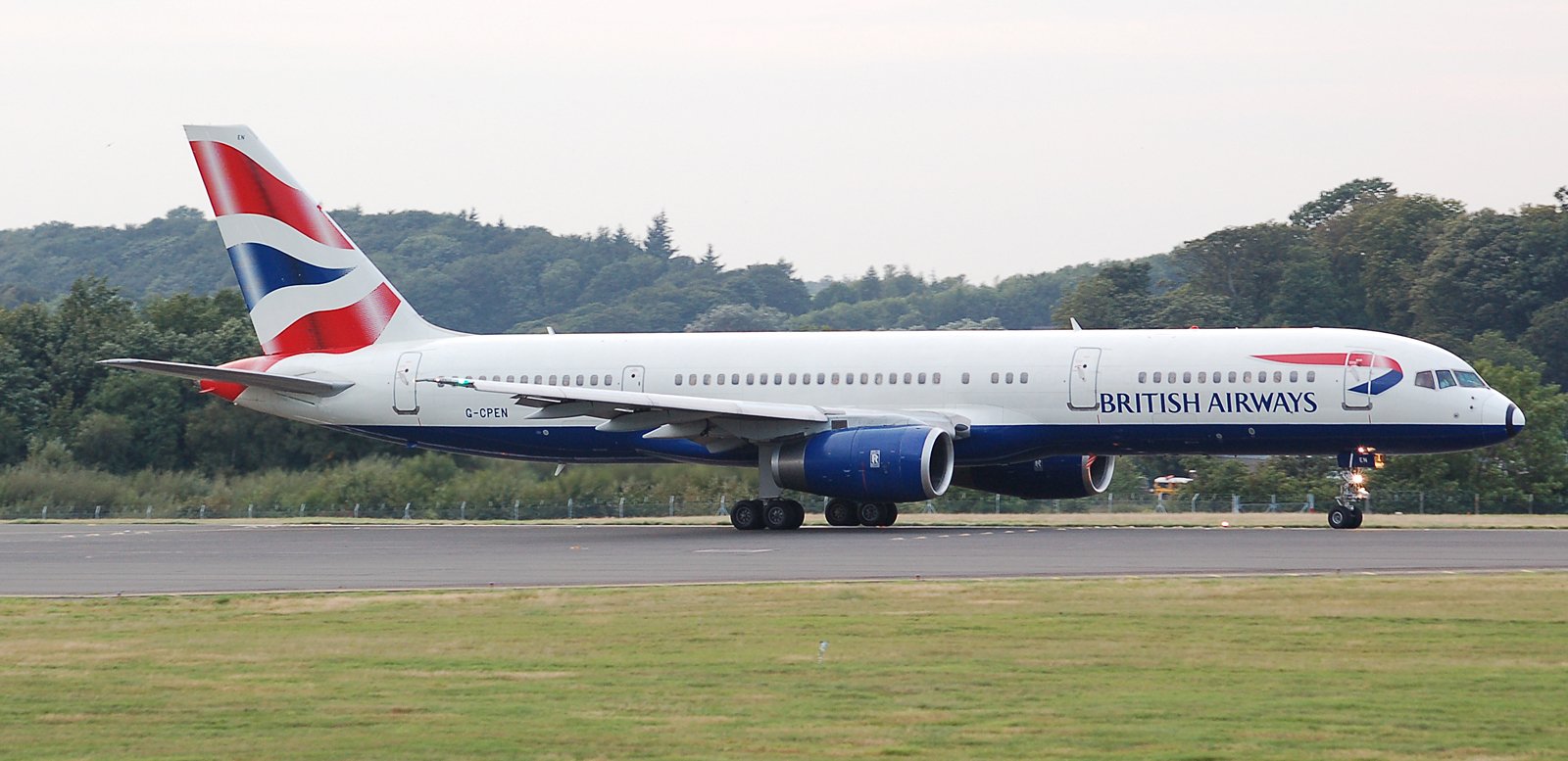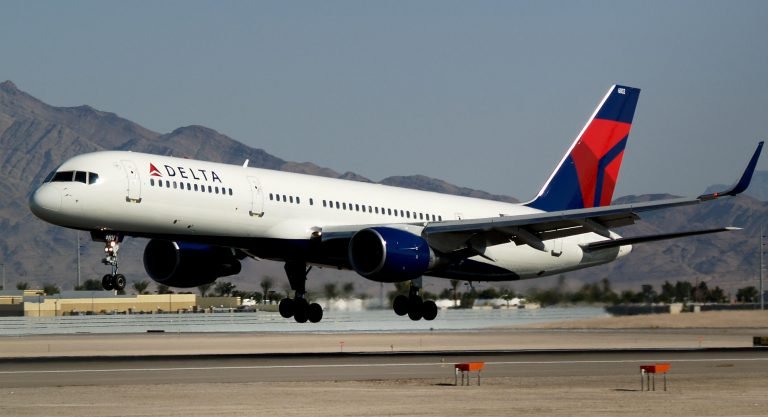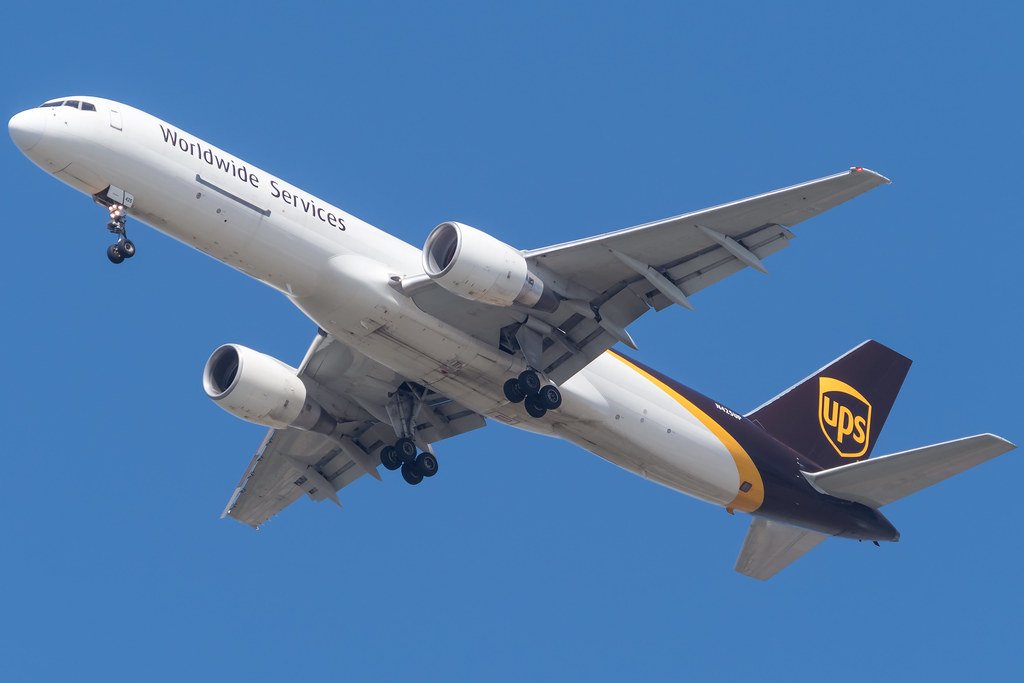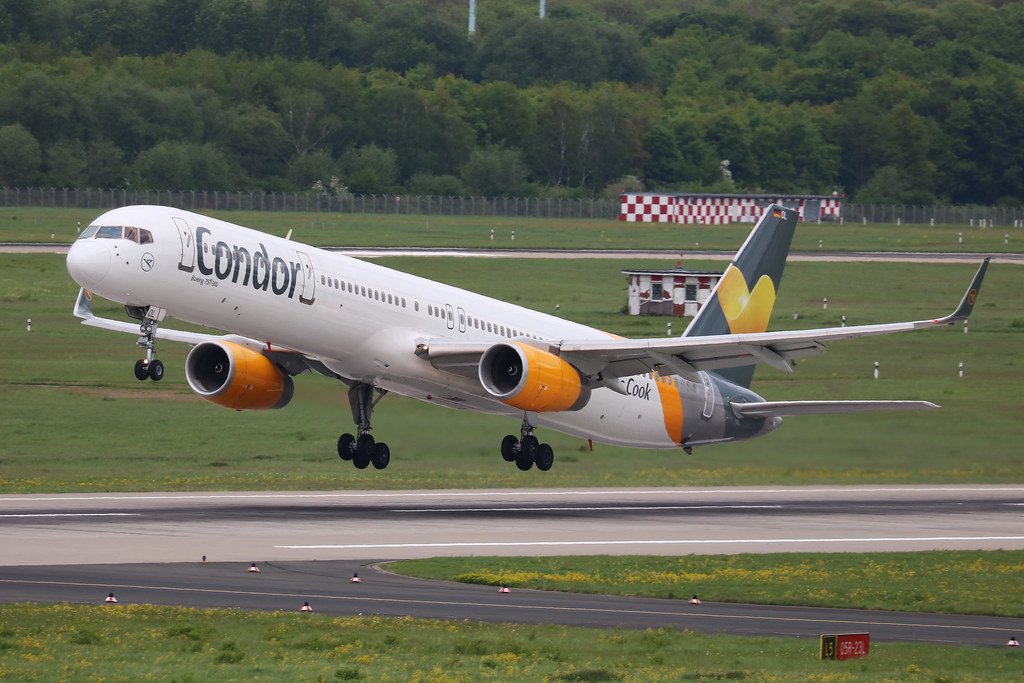
Boeing 757.
SPECS
HISTORY
ORDERS
British Airways Boeing 757-200 registration G-CPEN. On a personal note. I flew on one of British Airways’ first 757s on a Heathrow to Amsterdam flight in the 1980s. The pilot warned that the take-off would be a bit steeper than usual as they were demonstrating what this “sports car” airliner could do. He wasn’t kidding, it felt like we were going ballistic and I had never quite seen the ground at such an angle across the window when taking off on other aircraft. Quite an experience.
The Boeing 757 is a low-wing twin-jet airliner that was produced by Boeing Commercial Airplanes from 1981 to 2004. The 757 is a narrow-body airliner with the normal configuration being 3 seats on either side of a single aisle. Boeing designed the 757 alongside and slightly behind the Boeing 767. The 767, which is a wide-bodied airliner, and the 757 share many of the same design features in airframe as well as internal systems. This enables pilots to very quickly transfer from one type to the other with minimal retraining.
The 757 was Boeings’ replacement for the 727 which had enjoyed immense popularity and was still the mainstay of many airline fleets around the world. The initial concept floated by Boeing in the mid-1970s was to either create an updated 727, the 727-300, or to create a whole new twin-engined design known as the 7N7. Some interest was shown by United Airlines who provided input for the 727-300. but this died out after a while as airlines were more interested now in the new high by-pass turbofan engines which would not fit the 727 tri-jet.
SPECIFICATIONS
Boeing 757 Specs Table
| Model / Variant | 757-200 | 757-200PF | 757-300 |
|---|---|---|---|
| Flight Crew | 2 | ||
| Length | 47.3 metres (124 feet) | 54.47 metres (178 feet 8 inches) | |
| Wing Span | 38.05 Metres (124 feet 10 inches) | ||
| Tail height | 13.56 Metres (44 feet 6 inches) | ||
| Cabin Length (external) | 36.09 Metres (118 feet 5 inches) | 43.21 Metres (141 feet 9 inches) | |
| Cabin Width (internal) | 3.54 Metres (11 feet 6 inches) | ||
| Passenger Capacity | Mixed Class 200 / Single Class 239 | Nil | Mixed Class 243 / Single Class 295 |
| Empty Weight | 57,840 kg (127,520 lb) | 4,590 kg (142,400 lb) | |
| Maximum Take-off Weight (MTOW) | 115,680 kg (255,000 lb) | 123,600 kg (272,500 lb) | |
| Take-off Distance at ISA, Sea level, MTOW, using RB211-535E4B Engines | 1,981 m (6,500 ft) | 2,377 Metres (7,800 ft) | |
| Service Ceiling | 42,000 ft (12,800 m) 34,100 feet (10,400 m) cruise altitude |
||
| Maximum Cruising Speed | Mach 0.86 (493 knots, 913 km/h at 35,000 ft (11,000 m) cruise altitude) at an altitude of 34,100 feet (10,400 m) |
||
| Cruising Speed | Mach 0.80 (458 knots, 850 km/h at cruise altitude of 35,000 ft or 10,660 m) at an altitude of 34,100 feet (10,400 m) |
||
| Maximum Range Fully Laden | 7,222 km (3,900 nm) 7,600 km (4,100 nm) with winglets |
5,834 km (3,150 nm) | 6,287 km (3,395 nm) 6,658 km (3,595 nm) with winglets |
| Fuel Capacity | 43,490 Ltr (11,489 US gal) | 42,680 Ltr (11,276 US gal) | 43,400 Ltr (11,466 US gal) |
| Engines x 2 | Rolls-Royce RB211 or Pratt & Whitney PW2037 PW2040 |
Rolls-Royce RB211 Pratt & Whitney PW2037, PW2040, PW2043 |
|
| Engine Thrust | PW: 36,600–42,600 lbf (162.8–189.4 kN) RR: 37,400–43,500 lbf (166–193.5 kN) |
||
| Model / Variant | 757-200 | 757-200PF | 757-300 |
The 7N7, as the program was called, was to be a much more modern aircraft taking advantage of new technology and materials. Strangely enough, the T-tail which is a feature of the 727 tri-jet design actually remained one of the last things to be changed. The standard tail section finally adopted enabled a larger passenger capacity as it removed the more tapered rear fuselage design.
The early 1970s oil crisis saw a need to create a new more fuel-efficient design. With a target of a 20% reduction in fuel burn, Boeing set about designing the 757 using new lightweight materials as well as a redesigned wing that produced less drag.
The 757 had a high power-to-weight ratio which allowed it to operate efficiently out of hot and high-altitude airfields. It was able to beat its competitors who required longer runways to achieve the same lifting capacity.
History.
Delta Air Lines in its then New Livery Boeing 757-232 with Winglets N703TW.
The Boeing 757 was produced in three main variants. The first offering was the 757-200 which was by far the most popular model with 913 having been produced out of a total of 1,050 altogether. The 757-200 came in two configurations. Each had three doors on each side of the fuselage. The base model had a smaller door in addition just behind the wings, whereas the alternative version had two small overwing exits on each side. The type was capable of carrying from 224 to 239 passengers.
There was to be a 757-100, but this was seen as a doubling up on the territory already covered by the Boeing 737. The idea was shelved.
Rolling out of the Renton Factory for the first time on 13 January 1982, the prototype 757 was equipped with Rolls Royce RB211-535C engines.
She made her maiden flight a week ahead of schedule on 19 February 1982.
The first 5 757s built were used in stringent and punishing flight tests, including; cold climate, hot climate, high altitude airfields as well as route testing. Because of the commonality between the 757 and the 767, a lot of data was able to be cross-referenced between the two during testing.
Boeing 757-23N of Ethiopian Airlines ET-AMU.
A few minor modifications such as door springs and surface strengthening for bird strikes were made but the results were very pleasing for Boeing. The aircraft came in at 1,630Kg lighter than expected and enjoyed a 3% percent better than expected fuel burn result. This equated to extending the range by 200nm (370Km). Boeing was quick to highlight the economy of its new product.
Although orders looked promising to start with for the Boeing 757, the early 80s saw a bit of a drought in sales. Fuel prices had recovered from their early 70s spike and airlines were happy to sit on their older technology aircraft such as the Boeing 727, Douglas DC9, etc.. These aircraft were cheaper to buy and fuel economy was not as critical as it had been.
Just as the critical decision was about to be made to slow down production, a turnaround came. In the U.S.A., congestion at airline hubs was becoming a problem and this spurred the demand for larger aircraft to carry more passengers on fewer flights. At the same time, noise regulations were coming into force at most airports and this was a problem for the older first-generation jet airliners.
An order of 20 aircraft by Northwest Airlines saved the day and production continued in full swing.
Northwest Airlines Boeing 757-251 Registration N532US at New York, La Guardia (LGA).
A month later Boeing announced a new variant, the 757-200PF. This was a freighter model and 20 were ordered by UPS Airlines.
The Boeing 757-200 was initially designed for short to medium-haul routes as a replacement for the 727, however, airlines started to use the 757 for everything from high-density short shuttle routes to intercontinental trans-Atlantic routes.
The popularity of the 757 prompted Boeing to investigate further variants. It was their only single-aisle airliner that so far had not been offered in a stretched version. They looked at a 757X which would be a longer-range version but this met with little interest. The pressure was on to raise the capacity of the 757, particularly by European charter airlines who were already enjoying the longer range of this model.
Boeing 757-24APF UPS Airlines Registration N425UP. UPS ordered 20 of the freighter model.
At the Farnborough Airshow of September 1996, Boeing announced the plans for the 757-300. This variant would be 7.13 Metres (23 Feet 5 In.) longer than the 757-200. The project was kicked off by an order from Condor Flugdienst for 12 airframes.
A record-breaking 27 months from launch to certification saw the 757-300 rollout of the factory on 31 May 1998 and take its maiden flight on 02 August 1998. Condor put the type into service on 19 March 1999.
Whilst a few buyers were found for the Boeing 757-300, the sales never reflected those of the 757-200, with 55 sold in total. By November 1999 Boeing was forced to review the overall production of the 757 as sales started to slow down.
Boeing 757-300 Condor registration D-ABOL taking off from Dusseldorf.
In the early 2000s Boeing once again floated the idea of a long-range 757 version but this was once again met with little interest. A concerted sales effort gained a few more sales but the 757 was winding down. Airlines seemed once again to be gravitating toward smaller airliners like the Airbus A320 and the Boeing 737 which were being offered in a range of sizes. Boeing was also looking toward an all-new airliner which would eventually become the Boeing 787 Dreamliner.
Something Boeing had never done before, was to dabble in the airliner conversion space. In March of 2001, they produced the first 757-200SF which was a second-hand 757-200 converted to a freighter. Various modifications to the 200 enabled this to carry cargo on the main deck and hold below. Its capacity was nearly as high as the 757-200PF which was a purpose-built freighter. FedEx Express was a large customer for the type, spending US$2.4 Billion to replace their old 727s with 80 757-200SF conversions. By the middle of 2015, there were still 173 of the type in service.
FedEx Boeing 757-27B(SF) registration N916FD. FedEx replaced their aging Boeing 727 fleet with 80 757-200SFs.
Orders and Deliveries.
The 757 was initiated by 40 orders from both Eastern Air Lines and British Airways. The launch airline ended up being Eastern Air Lines which received its first Boeing 757 on 22 December 1982.
On 01 January 1983, they performed the first scheduled service from Atlanta to Tampa.
British Airways followed very shortly after with their introduction of the 757 onto the London to Belfast shuttle service on 09 February 1983. This was the beginning of their phasing out of the Hawker Siddeley Trident 3B.
| Breakdown by aircraft | Boeing 757 200 | Boeing 757 200PF | Boeing 757 300 |
|---|---|---|---|
| Orders | 914 | 80 | 55 |
| Deliveries | 914 | 80 | 55 |
| Unfilled Orders | - | - | - |
Boeing 757 Orders and Deliveries by Customer.
| Airline / Variant | Orders | Deliveries |
|---|---|---|
| Air China Southwest Branch | 12 | 12 |
| 757-200 | 12 | 12 |
| Air Europe | 29 | 15 |
| 757-200 | 29 | 15 |
| Air Florida | 3 | 0 |
| 757-200 | 3 | 0 |
| Air Holland Leasing | 3 | 3 |
| 757-200 | 3 | 3 |
| Aloha Airlines | 3 | 0 |
| 757-200 | 3 | 0 |
| America West Airlines | 14 | 4 |
| 757-200 | 14 | 4 |
| American Airlines | 141 | 126 |
| 757-200 | 141 | 126 |
| AOF Leasing | 2 | 0 |
| 757-200 | 2 | 0 |
| Arkia Israeli Airlines | 2 | 2 |
| 757-300 | 2 | 2 |
| ATA Airlines, Inc. | 25 | 25 |
| 757-200 | 13 | 13 |
| 757-300 | 12 | 12 |
| Avianca Costa Rica | 2 | 0 |
| 757-200 | 2 | 0 |
| Azerbaijan Airlines | 2 | 2 |
| 757-200 | 2 | 2 |
| British Airways | 52 | 50 |
| 757-200 | 52 | 50 |
| CAAC-Civil Aviation of China | 3 | 0 |
| 757-200 | 3 | 0 |
| China Southern Airlines | 19 | 19 |
| 757-200 | 19 | 19 |
| China Xinjiang Airlines | 6 | 6 |
| 757-200 | 6 | 6 |
| CIT Aerospace LLC | 1 | 0 |
| 757-300 | 1 | 0 |
| Condor Flugdienst | 30 | 30 |
| 757-200 | 17 | 17 |
| 757-300 | 13 | 13 |
| DAE Aerospace Enterprise | 25 | 25 |
| 757-200 | 21 | 21 |
| 757-200PF | 4 | 4 |
| Delta Air Lines | 116 | 116 |
| 757-200 | 116 | 116 |
| Eastern Air Lines | 27 | 25 |
| 757-200 | 27 | 25 |
| EL AL Israel Airlines | 7 | 7 |
| 757-200 | 7 | 7 |
| Electra Aviation Limited | 1 | 0 |
| 757-200 | 1 | 0 |
| Ethiopian Airlines Group | 5 | 5 |
| 757-200 | 4 | 4 |
| 757-200PF | 1 | 1 |
| Far Eastern Air Transport | 7 | 7 |
| 757-200 | 7 | 7 |
| GATX Financial Corporation | 3 | 3 |
| 757-200 | 3 | 3 |
| Government of Mexico | 1 | 1 |
| 757-200 | 1 | 1 |
| GPA Group | 53 | 12 |
| 757-200 | 53 | 12 |
| Hispania Lineas Aereas | 2 | 0 |
| 757-200 | 2 | 0 |
| Iberia Airlines | 24 | 24 |
| 757-200 | 24 | 24 |
| Icelandair | 9 | 8 |
| 757-200 | 7 | 7 |
| 757-300 | 2 | 1 |
| International Lease Finance Co | 83 | 82 |
| 757-200 | 83 | 82 |
| KE Aircraft Leasing | 2 | 2 |
| 757-200 | 2 | 2 |
| Airline / Variant(contd.) | Orders | Deliveries |
|---|---|---|
| L.T.E. International Airways | 1 | 1 |
| 757-200 | 1 | 1 |
| LTU | 12 | 12 |
| 757-200 | 12 | 12 |
| Mid East Jet | 1 | 1 |
| 757-200 | 1 | 1 |
| Monarch Airlines | 7 | 7 |
| 757-200 | 7 | 7 |
| MyTravel Airways | 1 | 1 |
| 757-200 | 1 | 1 |
| NAS Aviation Services LLC | 4 | 4 |
| 757-200 | 4 | 4 |
| Nepal Airlines Corporation | 2 | 2 |
| 757-200 | 1 | 1 |
| 757-200M | 1 | 1 |
| Northwest-Merged w Delta | 92 | 72 |
| 757-200 | 76 | 56 |
| 757-300 | 16 | 16 |
| Republic Airlines | 6 | 6 |
| 757-200 | 6 | 6 |
| Rolls-Royce A/C Management | 4 | 4 |
| 757-200 | 4 | 4 |
| Royal Air Maroc | 2 | 2 |
| 757-200 | 2 | 2 |
| Royal Brunei Airlines | 3 | 3 |
| 757-200 | 3 | 3 |
| Shanghai Airlines | 13 | 13 |
| 757-200 | 13 | 13 |
| Shorouk Air | 4 | 0 |
| 757-200 | 2 | 0 |
| 757-200PF | 2 | 0 |
| Singapore Airlines | 4 | 4 |
| 757-200 | 4 | 4 |
| Sojitz | 2 | 2 |
| 757-200 | 2 | 2 |
| Starflite Corporation | 1 | 1 |
| 757-200 | 1 | 1 |
| Sterling Air A/S | 3 | 3 |
| 757-200 | 3 | 3 |
| Thomas Cook Airlines | 2 | 2 |
| 757-300 | 2 | 2 |
| Thomson Airways - Duplicate (I | 1 | 0 |
| 757-200 | 1 | 0 |
| Transavia Airlines | 3 | 3 |
| 757-200 | 3 | 3 |
| Transbrasil | 9 | 0 |
| 757-200 | 9 | 0 |
| TUI Travel PLC | 16 | 16 |
| 757-200 | 16 | 16 |
| Turkmenhowayollary Agency | 3 | 3 |
| 757-200 | 3 | 3 |
| TWA | 14 | 14 |
| 757-200 | 14 | 14 |
| U.S. Air Force | 4 | 4 |
| 757-200 | 4 | 4 |
| United Airlines | 150 | 148 |
| 757-200 | 141 | 139 |
| 757-300 | 9 | 9 |
| United Airlines (Prev. Contine | 6 | 0 |
| 757-300 | 6 | 0 |
| UPS | 75 | 75 |
| 757-200PF | 75 | 75 |
| US Airways, Inc. | 46 | 23 |
| 757-200 | 46 | 23 |
| Uzbekistan Airways | 3 | 3 |
| 757-200 | 3 | 3 |
| Xiamen Airlines | 9 | 9 |
| 757-200 | 9 | 9 |
| Grand Total | 1217 | 1049 |











